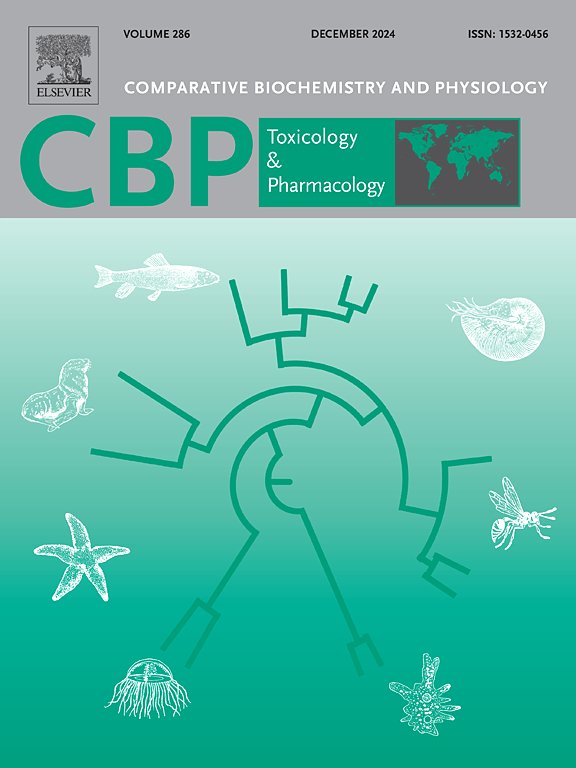Species-specific responses to di (2-ethylhexyl) phthalate reveal activation of defense signaling pathways in California sea lion but not in human skeletal muscle cells in primary culture
IF 3.9
3区 环境科学与生态学
Q2 BIOCHEMISTRY & MOLECULAR BIOLOGY
Comparative Biochemistry and Physiology C-toxicology & Pharmacology
Pub Date : 2024-12-06
DOI:10.1016/j.cbpc.2024.110106
引用次数: 0
Abstract
Higher antioxidant defenses in marine than terrestrial mammals allow them to cope with oxidative stress associated with diving-induced ischemia/reperfusion. Does this adaptation translate to inherent resistance to other stressors? We analyzed oxidative stress indicators in cells derived from human and California sea lion (Zalophus californianus) skeletal muscle upon exposure to di (2-ethylhexyl) phthalate (DEHP). Human abdominal muscle biopsies were collected from healthy women undergoing planned cesarean surgery. California sea lion samples were collected postmortem from stranded animals. Skeletal muscle cells derived from each species were exposed to 1 mM DEHP for 13 days (n = 25) or maintained under control (untreated) conditions (n = 25). Superoxide radical (O2•-) production, oxidative damage and antioxidant enzyme activities were measured using spectrophotometric methods. Gene expression was analyzed by RT-qPCR. DEHP exposure increased O2•- production and superoxide dismutase (SOD) activity in both species. Glutathione S-transferase (GST) activity and protein carbonyl levels increased in human but not in California sea lion cells. In contrast, glutathione peroxidase (GPx) and catalase (CAT) activities increased in California sea lion but not in human cells exposed to DEHP. In human cells, DEHP increased microsomal GST1 and GST (κ, μ, θ, ω, and ᴢ), while suppressing 8-oxoguanine DNA glycosylase (OGG1), CAT, glutathione reductase (GR), and nuclear factor erythroid 2-related factor 2 (NRF2) expression, suggesting increased oxidative stress and phase two detoxification processes. In California sea lion cells, DEHP increased OGG1, NRF2, GPx2 and SOD3 expression, suggesting activation of antioxidant defenses, which potentially contribute to maintaining redox homeostasis, avoiding oxidative damage.

对邻苯二甲酸二(2-乙基己基)酯的物种特异性反应揭示了加利福尼亚海狮防御信号通路的激活,但在原代培养的人类骨骼肌细胞中没有。
与陆地哺乳动物相比,海洋动物具有更高的抗氧化防御能力,这使它们能够应对与潜水引起的缺血/再灌注相关的氧化应激。这种适应是否转化为对其他压力源的内在抵抗力?我们分析了人类和加利福尼亚海狮骨骼肌细胞暴露于邻苯二甲酸二(2-乙基己基)酯(DEHP)后的氧化应激指标。从接受计划剖宫产手术的健康妇女中收集人体腹肌活检。加利福尼亚海狮的样本是在搁浅动物死后收集的。每个物种的骨骼肌细胞暴露于1 mM DEHP中13 天(n = 25)或保持在对照(未处理)条件下(n = 25)。用分光光度法测定超氧自由基(O2-)产生、氧化损伤和抗氧化酶活性。RT-qPCR分析基因表达。DEHP暴露增加了两种物种的氧生成和超氧化物歧化酶(SOD)活性。谷胱甘肽s -转移酶(GST)活性和蛋白羰基水平在人类细胞中升高,而在加利福尼亚海狮细胞中没有升高。相比之下,加州海狮的谷胱甘肽过氧化物酶(GPx)和过氧化氢酶(CAT)活性增加,而暴露于DEHP的人细胞则没有。在人细胞中,DEHP增加微粒体GST1和GST (κ、μ、θ、ω和ᴢ),同时抑制8-氧鸟嘌呤DNA糖基化酶(OGG1)、CAT、谷胱甘肽还原酶(GR)和核因子红系2相关因子2 (NRF2)的表达,提示氧化应激和第二阶段解毒过程增加。在加利福尼亚海狮细胞中,DEHP增加了OGG1、NRF2、GPx2和SOD3的表达,表明激活了抗氧化防御,这可能有助于维持氧化还原稳态,避免氧化损伤。
本文章由计算机程序翻译,如有差异,请以英文原文为准。
求助全文
约1分钟内获得全文
求助全文
来源期刊
CiteScore
7.50
自引率
5.10%
发文量
206
审稿时长
30 days
期刊介绍:
Part C: Toxicology and Pharmacology. This journal is concerned with chemical and drug action at different levels of organization, biotransformation of xenobiotics, mechanisms of toxicity, including reactive oxygen species and carcinogenesis, endocrine disruptors, natural products chemistry, and signal transduction with a molecular approach to these fields.

 求助内容:
求助内容: 应助结果提醒方式:
应助结果提醒方式:


